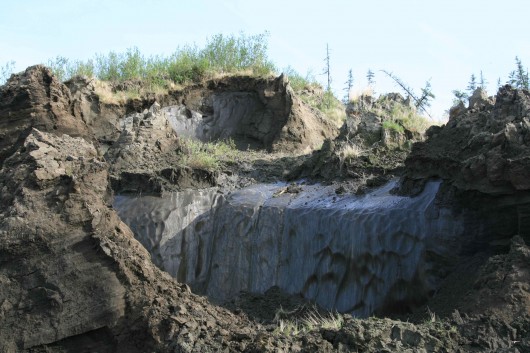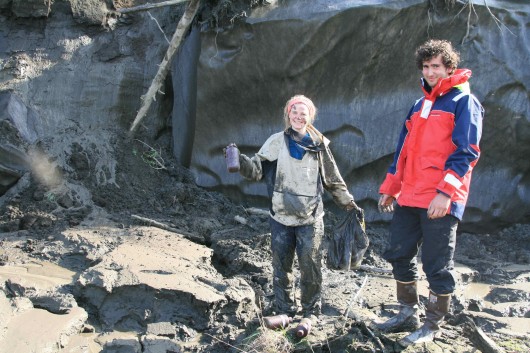Yesterday we (Elise, Jorien, Sam and, Nikita) went to this amazing site called Duvanni Yar: cliff several tens of meters high, in which the ice wedges were still visible. From the ice brown, silt-rich, small streams were running off together with big chunks of mud, tree parts, old bones and more mud, mud, mud. We had to crawl like crocodiles on our hand and feet to be sure not to get stuck in the mud. We needed to crawl to get to a small stream to collect 40 liters of water. Back in the boat we looked like real mud hunters :). This water is really interesting since it is all from Pleistocene-aged permafrost, which thaws a few meters off the cliff every summer. Since every year more and more organic matter from the permafrost will reach the Kolyma, it is important to know the differences between this 30,000 year old organic matter, and the ‘fresh’ Kolyma water.
Right now, the next morning, we are trying to filter all the collected water. All bottles are filled with 50% mud which only saves us a small amount of water from each bottle. It takes a lot of hours and a lot of filters, but when we finish we have clear melted ice wedge of Pleistocene age!

Ice wedge at Duvannyi Yar
After a week of collecting methane bubbles, I started a new project at the North East Science Station: trying to see what determines the breakdown of organic matter and the influence of salinity to show the changes the Kolyma water gets when it reaches the delta. To see how fast the organic compounds get degraded I measure BOD (measuring oxygen loss and determining the loss due to microbes respiration) on it almost every day. I also added PVP, an organic-compound-piece-cutter to increase the speed of organic matter breakdown. The same I will do with organic matter from Duvanni Yar. Here, I hope to find changes in organic compounds and the speed of breakdown between ‘new’ and ‘old’ thawed organic matter. I will also add different amounts of salt, to create different levels of salinity, to determine how salinity influences the speed of break down.
Being in this small Polaris group is definitely life changing. There is so much interesting science to be done here, and every day I can walk in a landscape which is undergoing fast changes. Old and new river paths streaming through thousands of lakes. Every hour has a different light level since the sun never goes down on the horizon. Together, with other researchers, we try to get the best out of every place we go to, and try to make the most out of everything.

Mud hunters




Comments(2)-
-
nienke says
June 27, 2013 at 11:37 amElise this sounds great! It must be a wonderful experience for you – I’m not a small amount jealous! Good luck with all the exciting work to all 🙂
Opa van Winden says
July 1, 2013 at 3:27 pmHoi Elise,Leuk en interessant om in de modder
te spelen;maar je geniet wel van alles daar begrijp ik.Alweer een nieuwe ervaring.
By the way: wij hadden toen wij in Greece woonden een zoontje die na 6 maanden zonder
regen nog onder de modder thuis kon komen!
Nog veel succes en tot ziens
Opa en Oma